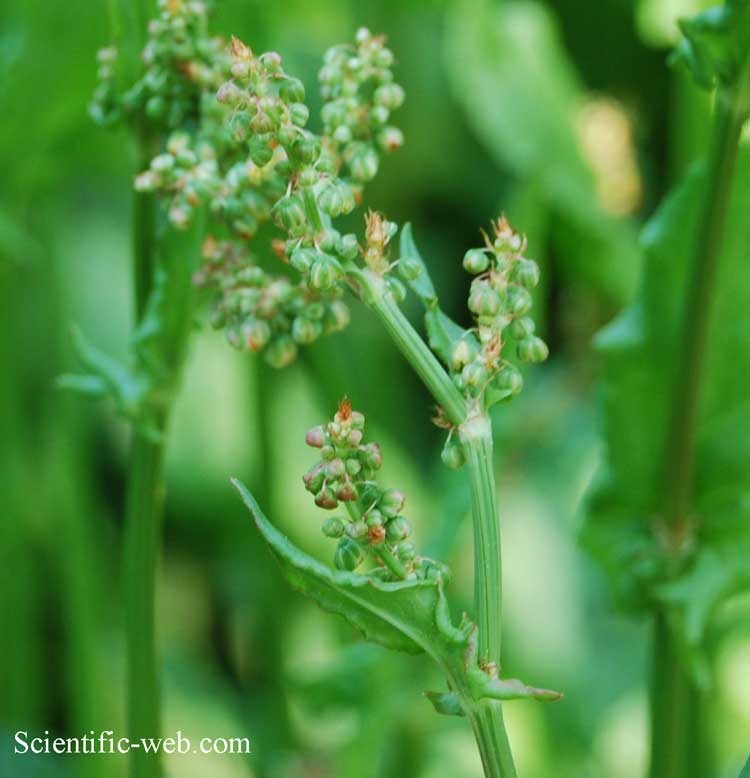
Rumex acetosa, Photo: Michael Lahanas
Classification System: APG IV
Superregnum: Eukaryota
Regnum: Plantae
Cladus: Angiosperms
Cladus: Eudicots
Cladus: Core eudicots
Ordo: Caryophyllales
Familia: Polygonaceae
Subfamilia: Polygonoideae
Tribus: Rumiceae
Genus: Rumex
Species: Rumex acetosa
Subspecies: R. a. subsp. acetosa – R. a. subsp. ambiguus – R. a. subsp. biformis – R. a. subsp. hibernicus – R. a. subsp. nebroides
Name
Rumex acetosa L. Sp. Pl. 1: 337. 1753, nom. cons.
References
Linnaeus, C. 1753. Species Plantarum. Tomus I: 337. Reference page.
USDA, ARS, Germplasm Resources Information Network. Rumex acetosa in the Germplasm Resources Information Network (GRIN), U.S. Department of Agriculture Agricultural Research Service.
Vernacular names
Afrikaans: Veldsuring
العربية: حماض بستاني
azərbaycanca: Adi əvəlik
Boarisch: Saueråmpfer
žemaitėška: Rūgštīnė
башҡортса: Ҡуҙғалаҡ
български: Киселец
català: Agrella
kaszëbsczi: Kwasné zelé
čeština: šťovík kyselý
Cymraeg: Suran y cŵn
dansk: Almindelig Syre
Deutsch: Wiesen-Sauerampfer
Zazaki: Amênvaş
Ελληνικά: Λάπαθο
English: Common Sorrel
Esperanto: Okzalo
español: Acedera común
eesti: Hapu oblikas
euskara: Mingarratz handi
فارسی: ترشک درشت
suomi: Niittysuolaheinä
Nordfriisk: Ruad jüd
français: Oseille commune
Gaeilge: Samhadh
galego: Aceda
हिन्दी: खट्टा पालक
hrvatski: Obična kiselica
hornjoserbsce: Kisały zdźer
magyar: mezei sóska
Ido: Oxalo
íslenska: Túnsúra
italiano: Acetosa
日本語: スイバ
ქართული: მჟაუნა
перем коми: Тшӧтшкӧр
한국어: 수영
kurdî: Tirşo
Līvõ kēļ: Appāina
lietuvių: Valgomoji rūgštynė
latviešu: Pļavas skābene
македонски: Киселец
norsk bokmål: Engsyre
Nederlands: Veldzuring
norsk nynorsk: Engsyre
Diné bizaad: Chaatʼíní
ирон: Хуырхæг
polski: szczaw zwyczajny
português: Azeda
română: Măcriș
русский: Щавель кислый
davvisámegiella: Juopmu
srpskohrvatski / српскохрватски: Kiseljak
slovenčina: štiav lúčny
slovenščina: Navadna kislica
српски / srpski: Кисељак
Seeltersk: Suurke
svenska: Ängssyra
тоҷикӣ: Туршак
українська: Щавель кислий
vèneto: Spanavin
vepsän kel’: Sol'hein
Tiếng Việt: Chút chít
中文: 酸模
Sorrel (Rumex acetosa), also called common sorrel or garden sorrel, is a perennial herbaceous plant in the family Polygonaceae. Other names for sorrel include spinach dock and narrow-leaved dock ('dock' is a common name for the genus Rumex).[2]
Sorrel is a common plant in grassland habitats and is often cultivated as a leaf vegetable or herb.
Description
Sorrel is a slender herbaceous perennial plant about 60 centimetres (24 inches) high, with roots that run deep into the ground, as well as juicy stems and arrow-shaped (sagittate) leaves.[3] The lower leaves are 7 to 15 centimetres (3 to 6 inches) in length with long petioles and a membranous ocrea formed of fused, sheathing stipules. The upper ones are sessile, and frequently become crimson. It has whorled spikes of reddish-green flowers, which bloom in early summer, becoming purplish.[4][2] The species is dioecious, with stamens and pistils on different plants.[2]
The leaves are eaten by the larvae of several species of Lepidoptera (butterfly and moth) including the blood-vein moth, as well as by non-specialized snails and slugs.
Distribution
Rumex acetosa occurs in grassland habitats throughout Europe from the northern Mediterranean coast to the north of Scandinavia and in parts of Central Asia. It occurs as an introduced species in parts of New Zealand, Australia and North America.[5] It can grow in poor soil.[3]
Subspecies
Several subspecies have been named.[2] Not all are cultivated:
Rumex acetosa ssp. acetosa
Rumex acetosa ssp. ambiguus
Rumex acetosa ssp. arifolius
Rumex acetosa ssp. hibernicus
Rumex acetosa ssp. hirtulus
Rumex acetosa ssp. vinealis
Uses
Common sorrel has been cultivated for centuries. The leaves are edible when young but toughen with age; they may be puréed in soups and sauces or added to salad.[3] The plant has a distinct sharp, sour taste. It contains oxalic acid, which can be poisonous in high quantities.[3]
In northern Nigeria, sorrel is used in stews, usually with spinach. In some Hausa communities, it is steamed and made into salad using kuli-kuli (traditional roasted peanut cakes with oil extracted), salt, pepper, onion and tomatoes. In India, the leaves are used in soups or curries made with yellow lentils and peanuts. In Afghanistan, the leaves are coated in a wet batter and deep fried, then served as an appetizer or if in season during Ramadan, for breaking the fast.
Throughout eastern Europe, wild or garden sorrel is used to make sour soups, stewed with vegetables or herbs, meat or eggs. In rural Greece, it is used with spinach, leeks, and chard in spanakopita. In Albania, the leaves are simmered and served cold marinated in olive oil, or as an ingredient for filling byrek pies (byrek me lakra). In Armenia, the leaves are collected in spring, woven into braids, and dried for use during winter. The most common preparation is aveluk soup, where the leaves are rehydrated and rinsed to reduce bitterness, then stewed with onions, potatoes, walnuts, garlic and bulgur wheat or lentils, and sometimes sour plums.
"Escalope de saumon à l'oseille" (salmon escalope in sorrel sauce), invented in 1962 by the Troisgros brothers, is an emblematic dish of the French nouvelle cuisine.[6][7] French cuisine traditionally cooks fish with sorrel because its acidity dissolves thin fish bones.[8]
See also
Sorrel (disambiguation)
Sorrel soup
References
"The Plant List: A Working List of All Plant Species", Theplantlist.org, retrieved 10 May 2016
Stace, C. A. (2010). New Flora of the British Isles (Third ed.). Cambridge, U.K.: Cambridge University Press. p. 446. ISBN 9780521707725.
Lyle, Katie Letcher (2010) [2004]. The Complete Guide to Edible Wild Plants, Mushrooms, Fruits, and Nuts: How to Find, Identify, and Cook Them (2nd ed.). Guilford, CN: FalconGuides. pp. 29–30. ISBN 978-1-59921-887-8. OCLC 560560606.
Blamey, M.; Fitter, R.; Fitter, A (2003). Wild flowers of Britain and Ireland: The Complete Guide to the British and Irish Flora. London: A & C Black. p. 64. ISBN 978-1408179505.
"Global spread map" (JPG). Linnaeus.nrm.se. Retrieved 23 December 2017.
Miller, Bryan; Franey, Pierre (1995-07-12). "GREAT COOKS; Finesse Times Two". The New York Times. ISSN 0362-4331. Retrieved 2019-05-05.
Boulud, Daniel; Greenspan, Dorie (1999). Daniel Boulud's Cafe Boulud Cookbook. Scribner. ISBN 978-0684863436.
Le Règne végétal. Librairie des sciences naturelles. 1864. p. 480.
Retrieved from "http://en.wikipedia.org/"
All text is available under the terms of the GNU Free Documentation License

